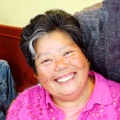The Japanese American experience has rarely been examined through a Sansei lens. Art by first-generation Issei and second-generation Nisei who were among the 120,000 incarcerated in American concentration camps during World War II has been well-documented, as has the heavily assimilated and media-centric landscape of younger API artists. But the third-generation Sansei have remained a shadow or sandwich generation subsumed between survivor guilt and filial piety on the one hand and kodomo no tame ni (sacrifice for our children) on the other.
The Issei identity was defined by immigration, the Nisei by the mass incarceration. But what does it mean to be Sansei? The four of us, in our 50s and 60s, were born too late to be incarcerated, but we all felt the silent anger, shame and grief.
We have a foot in two, maybe three worlds, struggling to find balance along the continuum of Japanese>American. We have been shaped by our grandparents’ Issei lifestyles and values, by our Nisei parents’ responses to incarceration and by pressures within our own lives to succeed in the mainstream rather than in the sheltered backwaters of ethnic enclaves.
We are distinct from the Yonsei, Gosei, and Hapa (fourth and fifth generation and mixed heritage) who did not grow up seeing themselves reflected in the eyes of a close-knit community. Their childhoods were sanitized of the mud and weeds and sidewalk interactions of traditional lifestyles and cultures. But many Sansei still remember our grandparents’ egg farms, strawberry ranches, and single-room occupancy hotels. Our responses to our heritage are diverse, yet remarkably similar, expressing themselves in family ties, community service, political awareness, and a hyper-sensitivity to equal justice for other marginalized peoples. We are Americanized and yet oblique, liberated yet bound by deeply felt obligation.
Why is our perspective important? Our nation is groping for ways to back out of the evolutionary dead-end of a fossil-fuel economy. At a time when traditional cultures around the globe are dying faster than endangered species, we can no longer look back “home” to replenish traditional values; Japan’s salarymen and AsiaPop dollies are almost as far removed from the ancient peasant ways as Japanese Americans are. Perhaps because of the inherited weight of the incarceration, Sansei still embody traces of 19th-century Meiji-era preserved in amber. And yet, it was the Sansei’s firm belief in the democratic process that helped our parents and grandparents win redress.
As we sift through the gifts and griefs of our families’ multi-generational American journeys, we reflect upon these questions: What do we treasure and what can we lay to rest? How do we prevent injustice from happening to others? How can we add to the multi-faceted and resilient wisdom America needs to meet the challenges of the 21st century?
—Shizue Seigel, participating artist of Distillations: Meditations on the Japanese American Experience
* * *
The essay above was written for the exhibition Distillations: Meditations on the Japanese American Experience, which featured over 80 artworks by four Sansei women: Reiko Fujii, Lucien Kubo, Shizue Seigel, and Judy Shintani. The exhibition was held at the Arts & Consciousness Gallery, John F. Kennedy University, Berkeley, California, August 17-September 18, 2010. It was co-sponsored by the Asian American Women Artists Association
Exhibition Statement
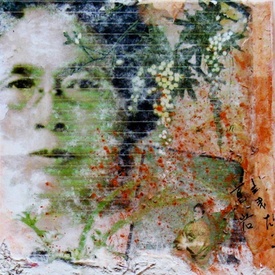
Shizue Seigel, "Rui (American Dreams, Part 2)," 2009. Mixed media: canvas, image-transferred photocollage, paper, acrylic pastes and mediums, copper dust, 12 x 12 in. Photo by artist.
We four Japanese American women artists draw from personal and family memories to reflect on “Japanese American” as singular label and as universal American experience.
To understand the Other is to embrace the totality of American experience: immigration and emigration, discrimination and civil liberties, war and heroism, incarceration and justice, economic opportunity and exploitation, preservation and erosion of place, diaspora and hybridity, external and internalized oppression, cultural heritage and baggage, tradition and innovation, family treasures and dysfunction.
At the beginning of a new century, with Asia and the Middle East on the rise, the Japanese American experience offers a lens for all Americans to revisit the Eastern philosophy of embracing an expansive and evolving “both-and” rather than limiting ourselves to “either-or.”
As hybrid Americans we celebrate both our commonalities and our differences; our uniqueness as Americans and our connection to the global community; and our attunement with present and with the resonance of history and tradition.
We employ a variety of media and techniques including collage, assemblage, glass, found objects, painting, photography, image transfer, word, video, installation, and performance to explore the rich, complex interplay of past and present in contemporary Asian American life.
Excerpt from the catalog Preface by Margo Machida, Ph.D., Associate Professor of Art History and Asian American Studies, University of Connecticut.
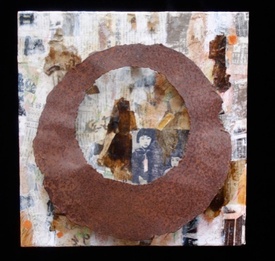
Lucien Kubo, "Japanese American Internment," 2005. Assemblage: found metal, collage on wood, 18 x 18 x 4 in. Photo by artist.
“….In visualizing their complexly entwined relationships to nation, community, family, sustaining cultural traditions, and spiritual beliefs, an abiding historical consciousness palpably threads through much of these socially engaged artists’ work. Significantly, as members of a generation born after World War II, their expressive efforts bear the psychic imprint of the Japanese American internment and its traumatic, disruptive effects, and thereby serve as vehicles to witness the past struggles and resilience of their forebears.
At the same time, each of these artists, informed by a wide-ranging world view firmly grounded in the immediacy of lived experience and unfolding events, unreservedly strives to be forward-looking in her ethical commitments, cross-cultural allegiances, and understandings of her times. Consequently, their themes and imagery—alongside those of other American artists of color—provide a necessary pivot to the realization of a more inclusive conception of our nation.”
Excerpt from the catalog Introduction by Betty Nobue Kano, MFA; Lecturer, Asian American Studies, San Francisco State University.
“….For Japanese Americans, beyond the historical crime of internment which is inextricably linked to family memories, happiness, hurt and dreams, are the unique personal stories of lives on the farm, in cities, as workers or in the military. These artists give us the substance, the tools and the motivation to understand our relations, identities, histories and ourselves. The art in Distillations is like an essential oil in the rhythm and purpose of each day that creates understanding within the soft parameters of our own and others’ memories. It reclaims the past into a new image, one that is linked to other communities and weaves universal experiences with the singularity of internment and the unique interplay of Japanese and American cultures.”
Artist Bios:
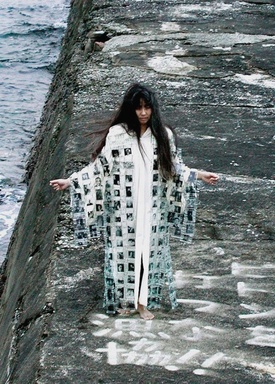
Reiko Fujii, "Glass Ancestral Kimono," 2002. Glass, copper wire, photographic reproductions, muslin, 48 x 42 x 7 in. Photo by Sambodh.
Shizue Seigel explores history, place, and spirituality through photographic and mixed media, painting, poetry and prose. She has exhibited locally, nationally and internationally. Solo shows include Double Vision: A Celebration of Hybridity, Ephemeral Allure, and Laramie Myths and Realities. She authored In Good Conscience: Supporting Japanese Americans during the Internment and is former editor of NJAHS’s Nikkei Heritage magazine. Her poetry and prose have appeared in several anthologies and in the Nikkei press. http://shizueseigel.com Exhibition images at www.flickr.com (Shizue Seigel).
Reiko Fujii is a third-generation Japanese American artist. With a sensitive heart, an artist’s eye and a determined interest in passing on stories of her Japanese American upbringing, she encapsulates snippets of her life experiences in video, performances and installations. She has exhibited her work in museums and galleries in California. She received a Master of Fine Arts degree from John F. Kennedy University, Berkeley and a BA in Psychology from UC Berkeley. www.reikofujii.com
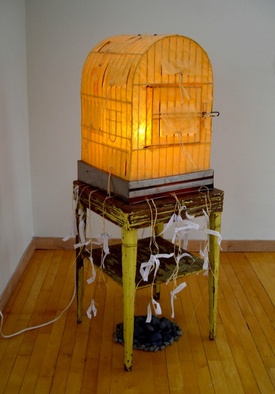
Judy Shintani, "Remembrance Shrine," 2007. Found objects, writing, light, 5 x 3 x 3 ft. Photo by artist.
Lucien Kubo is a Sansei, third-generation Japanese American. In the ‘70s she was involved in the San Francisco and Los Angeles Japanese community in redevelopment issues, redress/reparations, and opposition to the Vietnam war. Experiences are an integral part of her creative inspiration. She has curated exhibits on human rights and visual politics. Her artwork is mixed media/assemblage and shown in the Bay Area. A recent solo exhibit at the University of California, Santa Cruz’s Smith Gallery, Personal Memory, Public History, reflects her Japanese American experience.
Sansei artist Judy Shintani’s work depicts family stories, honors Japanese American history, showcases women’s issues, and offers viewers ways to participate and become art collaborators. She has exhibited throughout California and the Pacific Northwest. Shintani owns and runs the Kitsune Community Art Studio in Half Moon Bay, CA, and curates the Coastside Artists Doctors Without Borders Benefit. She has a MA in Transformative Art from John F. Kennedy University, Berkeley and a BS in Graphic Design from San Jose State University. www.judyshintani.com blog: http://judykitsune.wordpress.com/
@ 2010 Shizue Seigel


